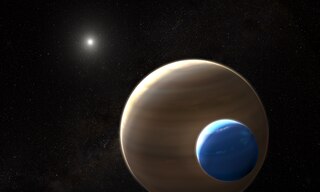Related Research Articles

An exomoon or extrasolar moon is a natural satellite that orbits an exoplanet or other non-stellar extrasolar body.

Any planet is an extremely faint light source compared to its parent star. For example, a star like the Sun is about a billion times as bright as the reflected light from any of the planets orbiting it. In addition to the intrinsic difficulty of detecting such a faint light source, the light from the parent star causes a glare that washes it out. For those reasons, very few of the exoplanets reported as of January 2024 have been observed directly, with even fewer being resolved from their host star.
This page describes exoplanet orbital and physical parameters.
PH1b, or by its NASA designation Kepler-64b, is an extrasolar planet found in a circumbinary orbit in the quadruple star system Kepler-64. The planet was discovered by two amateur astronomers from the Planet Hunters project of amateur astronomers using data from the Kepler space telescope with assistance of a Yale University team of international astronomers. The discovery was announced on 15 October 2012. It is the first known transiting planet in a quadruple star system, first known circumbinary planet in a quadruple star system, and the first planet in a quadruple star system found. It was the first confirmed planet discovered by PlanetHunters.org. An independent and nearly simultaneous detection was also reported from a revision of Kepler space telescope data using a transit detection algorithm.
Kepler-80, also known as KOI-500, is a red dwarf star of the spectral type M0V. This stellar classification places Kepler-80 among the very common, cool, class M stars that are still within their main evolutionary stage, known as the main sequence. Kepler-80, like other red dwarf stars, is smaller than the Sun, and it has both radius, mass, temperatures, and luminosity lower than that of our own star. Kepler-80 is found approximately 1,223 light years from the Solar System, in the stellar constellation Cygnus, also known as the Swan.

Kepler-37, also known as UGA-1785, is a G-type main-sequence star located in the constellation Lyra 209 light-years from Earth. It is host to exoplanets Kepler-37b, Kepler-37c, Kepler-37d and possibly Kepler-37e, all of which orbit very close to it. Kepler-37 has a mass about 80.3 percent of the Sun's and a radius about 77 percent as large. It has a temperature similar to that of the Sun, but a bit cooler at 5,357 K. It has about half the metallicity of the Sun. With an age of roughly 6 billion years, it is slightly older than the Sun, but is still a main-sequence star. Until January 2015, Kepler-37 was the smallest star to be measured via asteroseismology.
Kepler-32 is an M-type main sequence star located about 1053 light years from Earth, in the constellation of Cygnus. Discovered in January 2012 by the Kepler spacecraft, it shows a 0.58 ± 0.05 solar mass (M☉), a 0.53 ± 0.04 solar radius (R☉), and temperature of 3900.0 K, making it half the mass and radius of the Sun, two-thirds its temperature and 5% its luminosity.

Kepler-90, also designated 2MASS J18574403+4918185, is a F-type star located about 2,790 light-years (855 pc) from Earth in the constellation of Draco. It is notable for possessing a planetary system that has the same number of observed planets as the Solar System.
Kepler-88 is a G-type star 1,230 light-years away in the constellation of Lyra, with three confirmed exoplanets. SIMBAD lists a subgiant spectral type of G8IV, while other sources give it a main sequence spectral type of G6V. The latter is more consistent with its properties.

Kepler-23 is a G-type main-sequence star about 2,860 light-years away in the northern constellation of Cygnus, the swan. With an apparent visual magnitude of 13.5, it is too faint to be seen with the naked eye. This star is similar in mass and temperature to the Sun, but is larger and more luminous. Kepler-23 is orbited by three known exoplanets.

Kepler-26 is a star in the northern constellation of Lyra. It is located at the celestial coordinates: Right Ascension 18h 59m 45.8408s Declination +46° 33′ 59.438″. With an apparent visual magnitude of 15.5, this star is too faint to be seen with the naked eye.

Kepler-138, also known as KOI-314, is a red dwarf located in the constellation Lyra, 219 light years from Earth. It is located within the field of vision of the Kepler spacecraft, the satellite that NASA's Kepler Mission used to detect planets transiting their stars.

Sarah Ballard is an American astronomer who is a professor at the University of Florida. She has been a Torres Fellow at the Massachusetts Institute of Technology, a L'Oreal Fellow, and a NASA Carl Sagan Fellow.
Kepler-160 is a main-sequence star approximately the width of our Galactic arm away in the constellation Lyra, first studied in detail by the Kepler Mission, a NASA-led operation tasked with discovering terrestrial planets. The star, which is very similar to the Sun in mass and radius, has three confirmed planets and one unconfirmed planet orbiting it.
HAT-P-26 is a K-type main-sequence star located about 466 light-years away in the constellation of Virgo. A survey in 2015 did not find any stellar companions in orbit around it, although a red dwarf companion with a temperature 4000+100
−350 K is suspected on wide orbit.
Kepler-167 is a K-type main-sequence star located about 1,119 light-years (343 pc) away from the Solar System in the constellation of Cygnus. The star has about 78% the mass and 75% the radius of the Sun, and a temperature of 4,884 K. It hosts a system of four known exoplanets. There is also a companion red dwarf star at a separation of about 700 AU, with an estimated orbital period of over 15,000 years.
References
- ↑ "The Transit Timing Variation (TTV) Planet-finding Technique Begins to Flower".
- ↑ Steffen, Jason H.; Fabrycky, Daniel C.; Agol, Eric; Ford, Eric B.; Morehead, Robert C.; Cochran, William D.; Lissauer, Jack J.; Adams, Elisabeth R.; Borucki, William J.; Bryson, Steve; Caldwell, Douglas A.; Dupree, Andrea; Jenkins, Jon M.; Robertson, Paul; Rowe, Jason F.; Seader, Shawn; Thompson, Susan; Twicken, Joseph D. (2013). "Transit timing observations from Kepler – VII. Confirmation of 27 planets in 13 multiplanet systems via transit timing variations and orbital stability". Monthly Notices of the Royal Astronomical Society. 428 (2): 1077–1087. arXiv: 1208.3499 . Bibcode:2013MNRAS.428.1077S. doi: 10.1093/mnras/sts090 . S2CID 14676852.
- ↑ Xie, Ji-Wei (2013). "Transit Timing Variation of Near-Resonance Planetary Pairs: Confirmation of 12 Multiple-Planet Systems". The Astrophysical Journal Supplement Series. 208 (2): 22. arXiv: 1208.3312 . Bibcode:2013ApJS..208...22X. doi:10.1088/0067-0049/208/2/22. S2CID 17160267.
- ↑ Yang, Ming; Liu, Hui-Gen; Zhang, Hui; Yang, Jia-Yi; Zhou, Ji-Lin (2013). "Eight Planets in Four Multi-planet Systems via Transit Timing Variations in 1350 Days". The Astrophysical Journal. 778 (2): 110. arXiv: 1308.0996 . Bibcode:2013ApJ...778..110Y. doi:10.1088/0004-637X/778/2/110.
- ↑ Miralda-Escude (2001). "Orbital perturbations on transiting planets: A possible method to measure stellar quadrupoles and to detect Earth-mass planets". The Astrophysical Journal. 564 (2): 1019–1023. arXiv: astro-ph/0104034 . Bibcode:2002ApJ...564.1019M. doi:10.1086/324279. S2CID 7536842.
- ↑ Holman; Murray (2005). "The Use of Transit Timing to Detect Extrasolar Planets with Masses as Small as Earth". Science. 307 (1291): 1288–91. arXiv: astro-ph/0412028 . Bibcode:2005Sci...307.1288H. doi:10.1126/science.1107822. PMID 15731449. S2CID 41861725.
- ↑ Agol; Sari; Steffen; Clarkson (2005). "On detecting terrestrial planets with timing of giant planet transits". Monthly Notices of the Royal Astronomical Society . 359 (2): 567–579. arXiv: astro-ph/0412032 . Bibcode:2005MNRAS.359..567A. doi: 10.1111/j.1365-2966.2005.08922.x . S2CID 16196696.
- ↑ "Invisible World Discovered". NASA Kepler News. 8 September 2011. Archived from the original on 19 October 2011.
- ↑ Ballard, S.; Fabrycky, D.; Fressin, F.; Charbonneau, D.; Desert, J.-M.; Torres, G.; Marcy, G.; Burke, C. J.; Isaacson, H.; Henze, C.; Steffen, J. H.; Ciardi, D. R.; Howell, S. B.; Cochran, W. D.; Endl, M.; Bryson, S. T.; Rowe, J. F.; Holman, M. J.; Lissauer, J. J.; Jenkins, J. M.; Still, M.; Ford, E. B.; Christiansen, J. L.; Middour, C. K.; Haas, M. R.; Li, J.; Hall, J. R.; McCauliff, S.; Batalha, N. M.; Koch, D. G.; Borucki, W. J. (2011), "The Kepler-19 System: A Transiting 2.2 R🜨 Planet and a Second Planet Detected via Transit Timing Variations", Astrophysical Journal, 743 (2): 200, arXiv: 1109.1561 , Bibcode:2011ApJ...743..200B, doi:10.1088/0004-637X/743/2/200, S2CID 42698813
- ↑ Planet found tugging on transits Archived 2010-07-13 at the Wayback Machine , Astronomy Now, 9 July 2010
- ↑ Maciejewski, G.; Dimitrov, D.; Neuhäuser, R.; Niedzielski, A.; Raetz, S.; Ginski, C.; Adam, C.; Marka, C.; Moualla, M.; Mugrauer, M. (2010), "Transit timing variation in exoplanet WASP-3b", MNRAS, 407 (4): 2625, arXiv: 1006.1348 , Bibcode:2010MNRAS.407.2625M, doi: 10.1111/j.1365-2966.2010.17099.x , S2CID 120998224
- ↑ M Montalto; et al. (Nov 2, 2012). "A new analysis of the WASP-3 system: no evidence for an additional companion". MNRAS. 427 (4): 2757–2771. arXiv: 1211.0218 . Bibcode:2012MNRAS.427.2757M. doi: 10.1111/j.1365-2966.2012.21926.x . S2CID 59381004.
- ↑ Harrington, J.D. (26 August 2010). "NASA's Kepler Mission Discovers Two Planets Transiting Same Star". nasa.gov. Retrieved 4 September 2018.
- ↑ Johnson, Michele (26 January 2012). "NASA's Kepler Announces 11 Planetary Systems Hosting 26 Planets". nasa.gov. Retrieved 4 September 2018.
- ↑ Agol, E.; Deck, K. (2016), "Transit Timing to First Order in Eccentricity", Astrophysical Journal, 818 (2): 177, arXiv: 1509.01623 , Bibcode:2016ApJ...818..177A, doi: 10.3847/0004-637X/818/2/177 , S2CID 38941103
- ↑ Deck, K. M.; Agol, E.; Holman, M. J.; Nesvorný, D. (2014), "TTVFast: An Efficient and Accurate Code for Transit Timing Inversion Problems", Astrophysical Journal, 787 (2): 132, arXiv: 1403.1895 , Bibcode:2014ApJ...787..132D, doi:10.1088/0004-637X/787/2/132, S2CID 53965722
- ↑ Chambers, J. E. (1999), "A hybrid symplectic integrator that permits close encounters between massive bodies", MNRAS, 304 (4): 793–799, Bibcode:1999MNRAS.304..793C, CiteSeerX 10.1.1.25.3257 , doi: 10.1046/j.1365-8711.1999.02379.x
- ↑ Gillon, M.; Triaud, A. H. M. J.; Demory, B.-O.; Jehin, E.; Agol, E.; Deck, K. M.; Lederer, S. M.; de, Wit J.; Burdanov, A.; Ingalls, J. G.; Bolmont, E.; Leconte, J.; Raymond, S. N.; Selsis, F.; Turbet, M.; Barkaoui, K.; Burgasser, A.; Burleigh, M. R.; Carey, S. J.; Chaushev, A.; Copperwheat, C. M.; Delrez, L.; Fernandes, C. S.; Holdsworth, D. L.; Kotze, E. J.; Van, Grootel V.; Almleaky, Y.; Benkhaldoun, Z.; Magain, P.; Queloz, D. (2017), "Seven temperate terrestrial planets around the nearby ultracool dwarf star TRAPPIST-1", Nature, 542 (7642): 456–460, arXiv: 1703.01424 , Bibcode:2017Natur.542..456G, doi:10.1038/nature21360, PMC 5330437 , PMID 28230125
